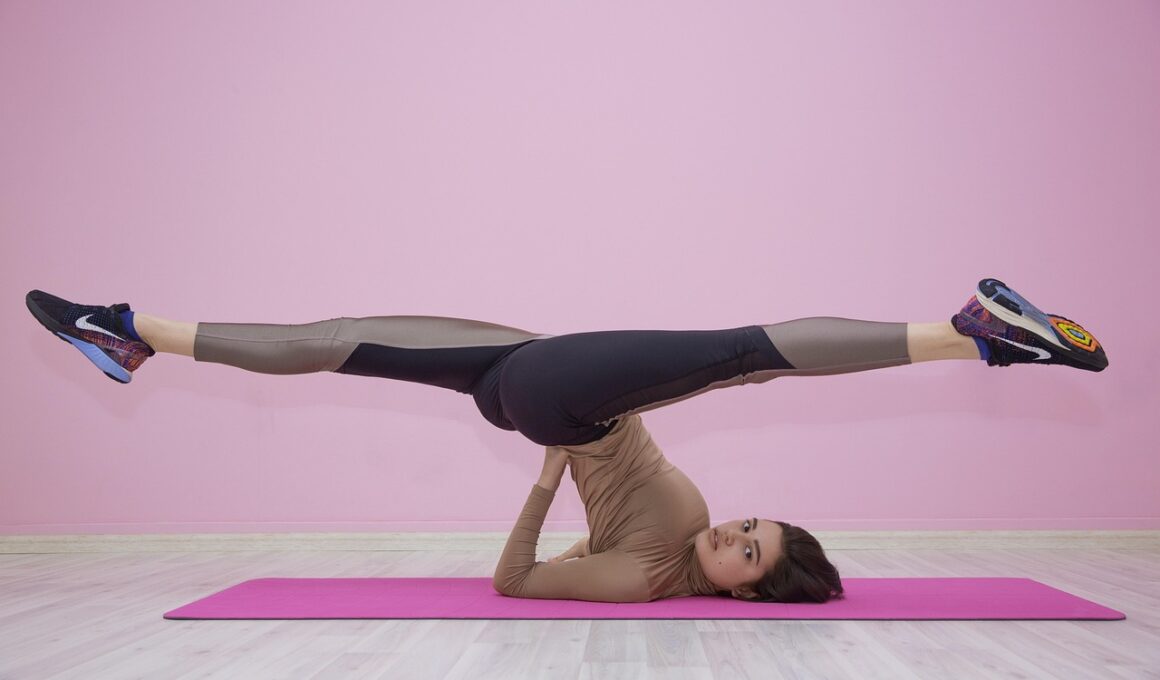How Yoga Improves Flexibility to Enhance Athletic Performance
Yoga has long been recognized for its ability to enhance flexibility. This flexibility is crucial for athletes as it allows for better performance and injury prevention. Flexibility not only improves overall movement but also supports muscle health and joint function. Athletes benefit from increased range of motion, which can lead to superior performance in their respective sports. Through a regular practice of yoga, athletes can engage in stretches that target specific muscle groups, enhancing their overall strength and coordination. Flexibility is particularly vital in sports that involve agility, rapid directional changes, and high levels of physical exertion. Regularly incorporating yoga into an athlete’s routine can also contribute to improved posture, balance, and focus. Practicing yoga helps cultivate mindfulness, enabling athletes to listen to their bodies and make adjustments accordingly. Moreover, the integration of breath control techniques in yoga increases lung capacity, improving endurance and stamina. This holistic improvement is integral for athletes looking to excel and reach their goals. Overall, yoga brings a plethora of benefits that can take athletic performance to the next level, promoting both physical and mental health.
To further understand how yoga impacts flexibility, we need to examine specific types of asanas and their benefits. Many yoga poses encourage stretching and lengthening of muscles, which is key for enhancing flexibility. Some of the most beneficial poses include forward bends, backbends, and hips openers. These positions not only stretch the muscles but also promote better blood flow and circulation. Additionally, engaging in poses like Downward Dog or Warrior can increase strength while simultaneously allowing for deeper stretches. Practicing these poses in a progressive manner can lead to longer-lasting flexibility improvements over time. Safety should be a priority; hence, proper alignment and gradual progression are essential to avoid injuries. Incorporating yoga in training programs can greatly enhance recovery from intense workouts, as gentle stretches promote muscle regeneration and elongation. The benefits are not only physical; they also include improved concentration and mental clarity. Athletes report feeling a heightened sense of presence and awareness in their bodies, leading to more mindful movements in their sports. Ultimately, the incorporation of these techniques can significantly improve an athlete’s performance level.
In addition, yoga provides mental benefits that directly influence athletic performance. Practicing mindfulness during yoga sessions helps athletes develop focus and concentration, essential skills for succeeding in competitive sports. This mindfulness practice enables athletes to clear their minds of distractions and become fully present in their activities. Additionally, a calm mind is beneficial for making better decisions during critical moments in competition. The breath control taught in yoga, or Pranayama, teaches athletes how to regulate their breathing in high-pressure situations, which can reduce anxiety and improve performance. Athletes often experience stress during competitions; thus, managing this anxiety is vital for achieving peak performance. Yoga prepares the mind and body by promoting relaxation and stress relief, allowing athletes to compete with greater confidence. Enhanced mental resilience is a common outcome of a consistent yoga practice, helping athletes to bounce back from defeats and maintain their motivation. This mental fortitude is as vital as physical strength, as sports often hinge on psychological factors. Therefore, integrating yoga into daily training will cultivate mental strength, improving overall athleticism.
The Role of Breathing Techniques
Breathing techniques in yoga significantly contribute to improved flexibility and performance for athletes. Proper breathing enhances oxygen flow to the muscles, leading to greater endurance during physical activities. When athletes engage in specific breathing exercises, they enhance their lung capacity, which is critical for stamina. Enhanced lung capacity allows for better oxygenation of the blood, supplying much-needed energy to working muscles. Breath awareness cultivates a connection between the mind and body, ensuring efficient movement patterns. Additionally, deeper breathing promotes relaxation, aiding recovery from intense workouts or competitive events. Athletes who master breathing techniques often report increased focus and concentration during skill execution. By synchronizing breath with movement, individuals can achieve a flow state, where they perform effortlessly and with optimal energy efficiency. Furthermore, maintaining a steady breath during physical exertion helps to regulate heart rate and reduces feelings of fatigue. This ability to control one’s breath can make a considerable difference in an athlete’s performance, especially in high-stakes situations. Thus, the focus on breath in yoga enhances overall athletic performance, making it a vital practice for anyone looking to improve in their sport.
Moreover, many athletes experience tightness and rigidity in their muscles due to rigorous training and competitive activities. Yoga serves as a perfect counterbalance to intense training, promoting flexibility and reducing muscle soreness. It helps in lengthening the muscles, thus preventing injuries that can arise from muscle overuse. Practicing restorative yoga poses can speed up recovery and alleviate tightness. The gentle stretches and mindful movements decrease lactic acid buildup and improve blood circulation. Additionally, relaxation techniques included in yoga aid in recovery by calming the nervous system. Athletes can integrate yoga sessions to enhance their post-workout recovery routine. By incorporating yoga as a cool-down practice, athletes can release muscle tension accumulated throughout the training. This restorative approach not only improves flexibility but also prepares the body for the next workout or competition. Moreover, adding yoga into an athlete’s regimen aids in maintaining long-term physical wellness and performance sustainability. The synergy between stretching in yoga and strength training creates an ideal balance that prevents injuries. As such, many sports teams are now incorporating yoga into their training programs to boost performance and promote overall health.
Nutrition also plays a pivotal role in enhancing flexibility when combined with yoga. Athletes need to fuel their bodies appropriately to support rigorous performance demands. Proper hydration, nutrient-rich foods, and adequate protein intake all contribute to muscle recovery and flexibility. Yoga promotes awareness of bodily sensations, encouraging athletes to pay attention to their nutrition and dietary habits. Incorporating anti-inflammatory foods rich in Omega-3 fatty acids, antioxidants, and high-quality proteins can enhance flexibility and muscle health. Foods such as nuts, seeds, leafy greens, and lean meats are essential to fuel performance. Furthermore, yoga teaches athletes to listen to their bodies regarding food needs. This mindfulness translates to making better food choices that support flexibility and overall health. Staying hydrated is equally essential; proper hydration maintains elasticity in muscles, enabling them to stretch more effectively. Athletes should prioritize hydration before, during, and after workouts. Ultimately, a holistic approach combining yoga, nutrition, and hydration can lead to optimal athletic performance and enhanced flexibility. Athletes must consider the synergy of these components essential for their success.
Conclusion: The Path Forward
In conclusion, yoga is a powerful practice that enhances flexibility and supports athletic performance. Through its various techniques, athletes can achieve many benefits that contribute to overall physical and mental health. The integration of specific yoga poses, breathing techniques, and mindfulness culminates in improved performance, reduced risk of injuries, and enhanced recovery. Yoga provides tools for athletes to cultivate resilience and maintain focus amid competition. As sports become increasingly competitive, those who embrace yoga can gain a significant advantage. By committing to a regular yoga practice, athletes can experience profound transformation in their bodies and minds. Additionally, understanding the role of nutrition and hydration complements the physical benefits of yoga. This comprehensive approach to training ensures athletes reach their peak potential while fostering long-term health and wellness. Teams and individuals alike must recognize the importance of incorporating yoga into their routines for sustained performance improvement. The path forward involves embracing a holistic strategy that encompasses all aspects of athletic training, leading to enhanced flexibility and overall excellence in sports.
Incorporating yoga into daily routines allows athletes to progress steadily toward their fitness goals. The gradual improvements cultivated in flexibility and overall performance can lead to extraordinary achievements. With consistent practice, athletes will notice enhanced movement capabilities and a greater connection with their physical selves. The beneficial effects of yoga foster a comprehensive approach to athletic training that transcends physical boundaries. Further, athletes must encourage their peers and coaches to embrace yoga’s advantages as part of an effective team strategy. Creating a culture that values flexibility and mindfulness will lead to a healthier, more successful athletic environment. Through teamwork, athletes can share in the process of improving together, embracing new ideas and practices that enhance their training. As the world of sports continues to evolve, staying at the forefront with innovative approaches such as yoga will set athletes apart. The journey of athleticism is not solely about competition but embracing holistic practices that promote well-being, resilience, and growth. Thus, cultivating such a supportive and nurturing atmosphere will inspire athletes to explore the benefits of yoga further.


